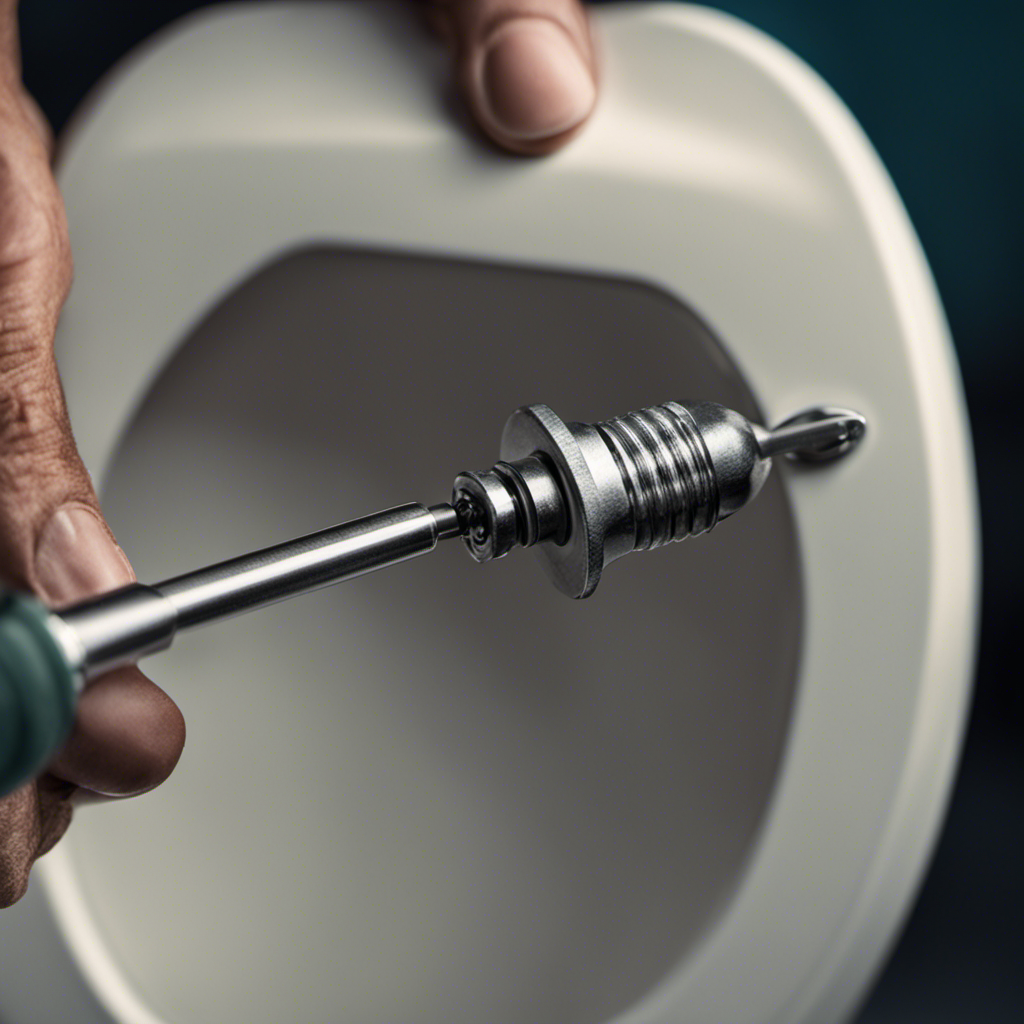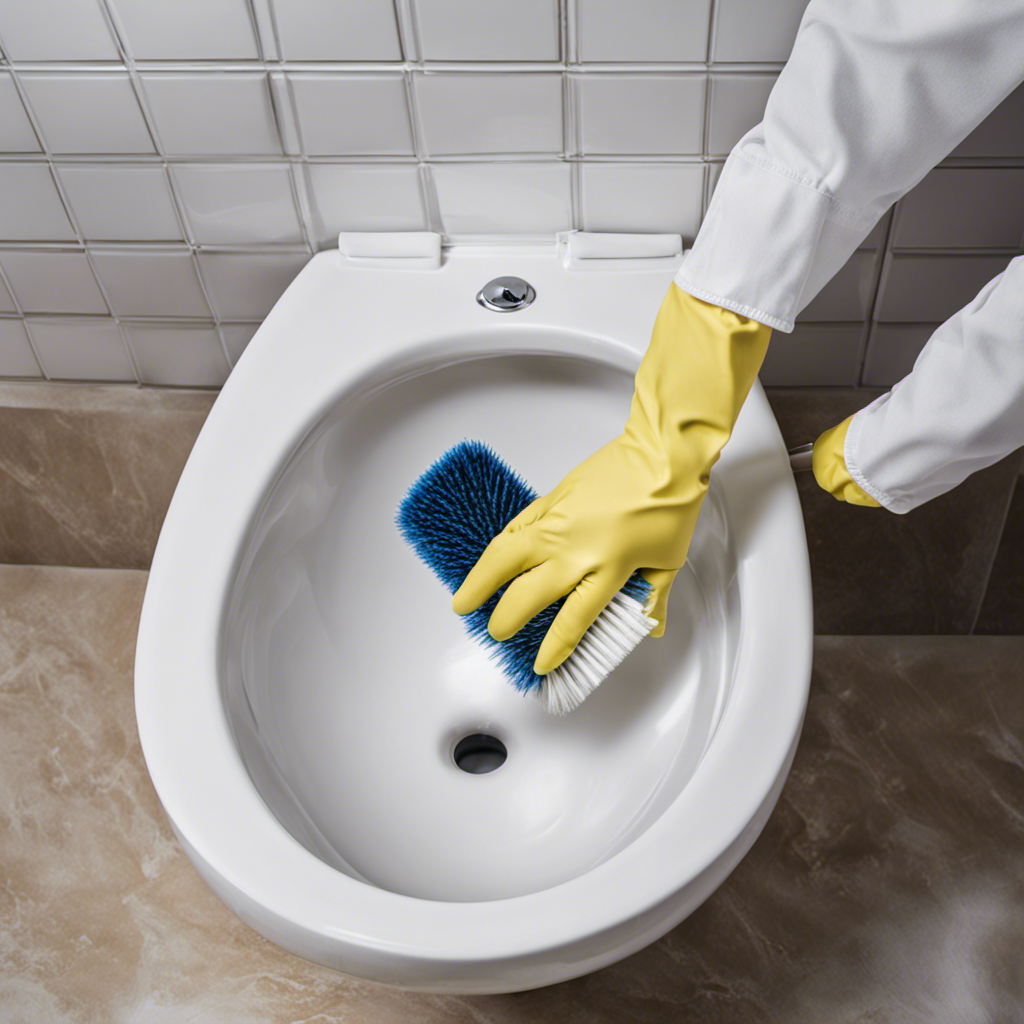I know what you’re thinking. Fixing a loose toilet seat might sound like a daunting task, but I assure you, it’s easier than you think.
In this article, I will guide you through the step-by-step process of assessing the problem, gathering the necessary tools, and securing the toilet seat to the bowl.
By following these instructions, you’ll be able to restore stability to your toilet seat and avoid any unnecessary wobbling.
So let’s get started and fix that loose toilet seat once and for all.
Key Takeaways
- Visually inspect the seat and hinges for signs of damage or wear.
- Tighten nuts or replace damaged bolts as a troubleshooting step.
- Consider the size, shape, and material of the replacement seat.
- Use adhesive strips as an alternative method for securing a wobbly seat.
Assessing the Problem
First, you’ll want to check if the toilet seat is securely attached. Assessing the issue of a loose toilet seat requires a systematic approach.
Start by visually inspecting the seat and hinges for any visible signs of damage or wear.
Next, try gently pushing and pulling the seat to see if it wobbles or moves excessively. If it does, the problem might lie with the bolts or nuts that secure the seat to the toilet bowl.
Use troubleshooting techniques like tightening the nuts or replacing damaged bolts to fix the issue.
Additionally, check if the seat itself is still in good condition and not cracked or broken.
Gathering the Necessary Tools
To get started, you’ll need a screwdriver and a wrench to tighten the bolts on the underside of the seat. Make sure to choose the right replacement if tightening doesn’t solve the issue.
Here are some alternative solutions to consider:
-
Check the size and shape of the toilet bowl: Different toilets have different seat dimensions, so it’s important to find a replacement that matches the shape and size of your toilet bowl.
-
Consider the material: Toilet seats come in various materials like plastic, wood, or cushioned. Each material offers different levels of durability, comfort, and maintenance requirements.
-
Look for additional features: Some toilet seats come with features like soft-close hinges or built-in bidets. Determine if you want any additional features for your replacement.
Removing the Loose Toilet Seat
To address a loose toilet seat, there are two possible solutions. One option is to tighten the seat screws. This involves using a screwdriver or wrench to tighten the screws that connect the seat to the toilet bowl. If the screws are damaged or the seat is beyond repair, the other solution is to replace the seat entirely. This requires removing the old seat and installing a new one.
Tightening the Seat Screws
You can easily fix a loose toilet seat by tightening the screws. Here’s what you need to do:
- Start by locating the screws that secure the seat to the toilet bowl.
- Use a screwdriver or a wrench to turn the screws clockwise to tighten them.
- Make sure not to overtighten, as this can cause damage to the seat or the toilet bowl.
If the screws are loose but won’t tighten, you may need to repair any cracks or damage around the screw holes. Fill the cracks with epoxy or a suitable adhesive and allow it to dry before attempting to tighten the screws again.
If the seat is still wobbly after tightening the screws, you may need to adjust the hinge tension. Look for adjustment screws or knobs on the hinges and turn them clockwise to increase tension.
Replacing the Seat
If the seat is damaged beyond repair, it may be time for a replacement. When installing a new toilet seat, it is important to ensure proper alignment and stability.
Start by removing the old seat by unscrewing the bolts underneath. Once the old seat is removed, clean the area thoroughly before proceeding.
Next, place the new seat onto the toilet bowl, making sure the holes on the seat align with the holes on the bowl. Insert the bolts through the holes and tighten them with a screwdriver.
To ensure a secure fit, adjust the alignment of the seat by tightening or loosening the bolts as needed. Finally, test the seat to make sure it is stable and doesn’t wobble.
Inspecting and Cleaning the Hinges
Take a moment to check and clean the hinges of your loose toilet seat. This step is crucial in preventing future loosening and maintaining the stability of your seat.
Here are some cleaning techniques you can use:
- Start by removing the seat and lid from the toilet bowl.
- Use a mild cleaning solution or bathroom cleaner to wipe down the hinges. Make sure to remove any dirt or grime that may have accumulated.
- For stubborn stains or buildup, you can use a toothbrush or small scrub brush to gently scrub the hinges.
- After cleaning, rinse the hinges thoroughly with water to remove any residue from the cleaning solution.
Securing the Toilet Seat to the Bowl
To ensure a stable and secure toilet seat, two effective methods can be used: tightening the seat and using adhesive strips.
Tightening the seat involves adjusting the bolts or screws that connect the seat to the bowl, ensuring a snug fit.
Adhesive strips, on the other hand, provide an additional layer of support by sticking the seat to the bowl, preventing any movement or wobbling.
Tightening the Seat
You can easily tighten the loose toilet seat by using a screwdriver. Here’s how:
- Start by locating the hinges of the toilet seat.
- If the hinges are damaged or worn out, consider replacing them to ensure a secure fit.
- Remove the old hinges by unscrewing them from the toilet bowl.
- Place a rubber washer over each screw hole on the toilet bowl.
- The rubber washer acts as a buffer and helps prevent the seat from becoming loose again.
- Make sure the rubber washer is centered over the hole for optimal effectiveness.
- Align the seat with the rubber washers and insert the screws through the holes.
- Tighten the screws firmly, but avoid over-tightening as it may cause damage.
- Test the seat to ensure it is securely in place.
Using Adhesive Strips
Using adhesive strips is an alternative method for securing a wobbly toilet seat. This solution is simple and effective, providing stability and preventing the seat from moving. Adhesive strips are easy to apply and can be found at hardware stores or online.
To use adhesive strips, follow these steps:
- Clean the surface of the toilet bowl and seat with a mild cleaner to remove any dirt or debris.
- Cut the adhesive strip into smaller pieces that fit the underside of the seat.
- Peel off the backing of the adhesive strip and press it firmly onto the toilet bowl.
- Repeat this process for all sides of the seat, ensuring that the adhesive strips are evenly spaced.
- Allow the adhesive strips to set for the recommended time before using the toilet.
Adhesive strips provide a reliable and cost-effective solution for fixing a loose toilet seat. They eliminate the need for tightening screws or bolts, making them a convenient alternative solution.
Testing the Stability of the Fixed Toilet Seat
Once the toilet seat is securely tightened, give it a gentle shake to test its stability. This is an important step in ensuring that the seat is fixed properly and won’t come loose again.
Here are some testing techniques and troubleshooting tips to help you with this process:
-
Visual Inspection:
-
Check for any visible signs of looseness or movement.
-
Look for cracks or damage in the seat or hinges.
-
Ensure that the seat is aligned correctly with the toilet bowl.
-
Stability Test:
-
Apply pressure to different areas of the seat to check for any wobbling or shifting.
-
Sit on the seat and test its stability by moving around slightly.
-
Push down on the seat to see if it remains securely in place.
-
Re-tightening:
-
If you notice any instability, try tightening the seat screws further.
-
Use a screwdriver to ensure a snug fit without over-tightening.
Maintaining a Secure Toilet Seat
To keep the toilet seat securely in place, regularly check for any signs of instability or movement. Prevention is key to avoiding toilet seat damage and ensuring a safe and comfortable experience for users.
One alternative method for securing a loose toilet seat is to use rubber washers. Simply remove the seat and hinges, place the rubber washers between the seat and the toilet bowl, and reattach the hinges tightly. This will provide added stability and prevent the seat from wobbling.
Another option is to use adhesive strips or pads. These can be applied to the underside of the seat and the toilet bowl to create a stronger bond.
Remember to always follow the manufacturer’s instructions and guidelines when making any adjustments or repairs to your toilet seat.
Frequently Asked Questions
How Often Should I Check the Tightness of My Toilet Seat?
I check the tightness of my toilet seat every few months. Signs of a loose toilet seat include wobbling or shifting when sitting on it. It’s important to replace a toilet seat if it becomes loose or damaged.
Can I Use Any Type of Wrench to Remove the Bolts Holding the Seat in Place?
Using the wrong wrench to remove the bolts holding the seat can cause damage. It’s important to use the correct size and type of wrench. Alternatively, you can try using pliers or an adjustable wrench.
Is It Necessary to Remove the Entire Toilet Seat or Can I Just Tighten the Hinges?
Toilet seat repair can be done without removing the entire seat. There are alternative methods to tighten the hinges, eliminating the need for removal. These methods ensure a secure and stable seat.
What Should I Do if the Hinges Are Damaged or Broken?
If the hinges on your toilet seat are damaged or broken, you will need to remove the seat and replace the hinges. Repairing hinges is not possible, so replacement is the best solution.
How Can I Prevent My Toilet Seat From Becoming Loose Again in the Future?
To prevent my toilet seat from becoming loose again in the future, I ensure proper toilet seat maintenance by regularly checking the hinges and tightening them if needed. Choosing the right toilet seat that fits securely is also crucial.
Conclusion
In conclusion, fixing a loose toilet seat is a simple task that can be done with just a few tools and some basic knowledge.
By assessing the problem, gathering the necessary tools, and following the steps to remove, inspect, and clean the hinges, you can ensure a secure toilet seat.
By securely fastening the seat to the bowl and testing its stability, you can enjoy a wobble-free experience.
Remember to maintain the secure toilet seat for long-lasting results.
So go ahead and give it a try, and say goodbye to that wobbly seat!










